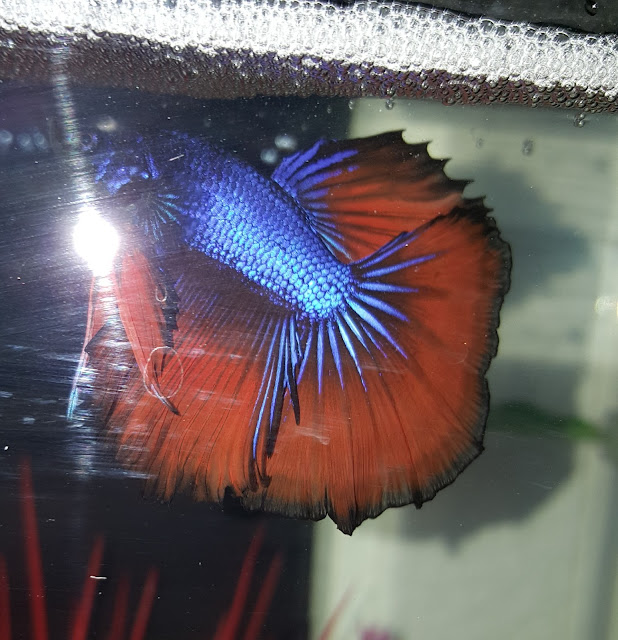The Marble Gene
Some of those who own bettas may be familiar with the marble gene, or marbling gene, or jumping gene.
This is a "hidden" gene within the betta's DNA, completely harmless, but with a very unique side effect.
It causes extreme, random color changes throughout the fish's life. Not mild or subtle, most bettas' colors will darken or become more vibrant in the months after purchase. I'm talking about a blue fish turning red, or a red fish turning yellow, or a green fish turning purple.
Or a white fish turning black.
Illy has the marble gene. It took me completely by surprise. I've had him for over six months. And for over six months, he looked like this:
Beautiful, right? He's a gorgeous boy.
But the other day, a week or so ago, I noticed a bit of a change.
Okay, he definitely didn't have that much black! I have a marbling fish!
It looks black in all but the brightest light. When you shine a bright light on him, you can see that it's actually a very dark blue. It just looks black.
Now, he's almost completely black, the color has moved further into his anal and caudal fins, and his dorsal fin is starting to show bits of black at the bottom. His ventral and pectoral fins are still white, and his head is still white, but if I hadn't seen him change for myself, I wouldn't have believed it. Not in such a short time.
The second picture and the last were only taken a week apart. That's how fast the colors can change.
And it's completely random. There's no way to know your fish has it until it changes color, and no way to know when or how often it will change color.
I've never had a marble fish before. It's awesome! I'm excited to see how his colors change as he gets older.
This is a "hidden" gene within the betta's DNA, completely harmless, but with a very unique side effect.
It causes extreme, random color changes throughout the fish's life. Not mild or subtle, most bettas' colors will darken or become more vibrant in the months after purchase. I'm talking about a blue fish turning red, or a red fish turning yellow, or a green fish turning purple.
Or a white fish turning black.
Illy has the marble gene. It took me completely by surprise. I've had him for over six months. And for over six months, he looked like this:
Beautiful, right? He's a gorgeous boy.
But the other day, a week or so ago, I noticed a bit of a change.
Did he always have that much black? No, I must be misremembering things.
Okay, he definitely didn't have that much black! I have a marbling fish!
It looks black in all but the brightest light. When you shine a bright light on him, you can see that it's actually a very dark blue. It just looks black.
Now, he's almost completely black, the color has moved further into his anal and caudal fins, and his dorsal fin is starting to show bits of black at the bottom. His ventral and pectoral fins are still white, and his head is still white, but if I hadn't seen him change for myself, I wouldn't have believed it. Not in such a short time.
The second picture and the last were only taken a week apart. That's how fast the colors can change.
And it's completely random. There's no way to know your fish has it until it changes color, and no way to know when or how often it will change color.
I've never had a marble fish before. It's awesome! I'm excited to see how his colors change as he gets older.







Comments
Post a Comment